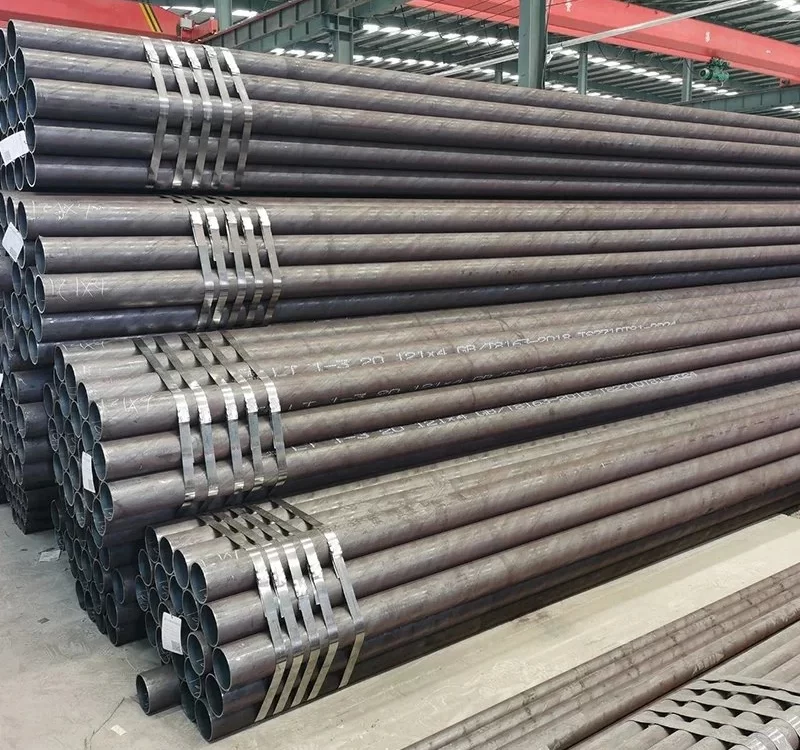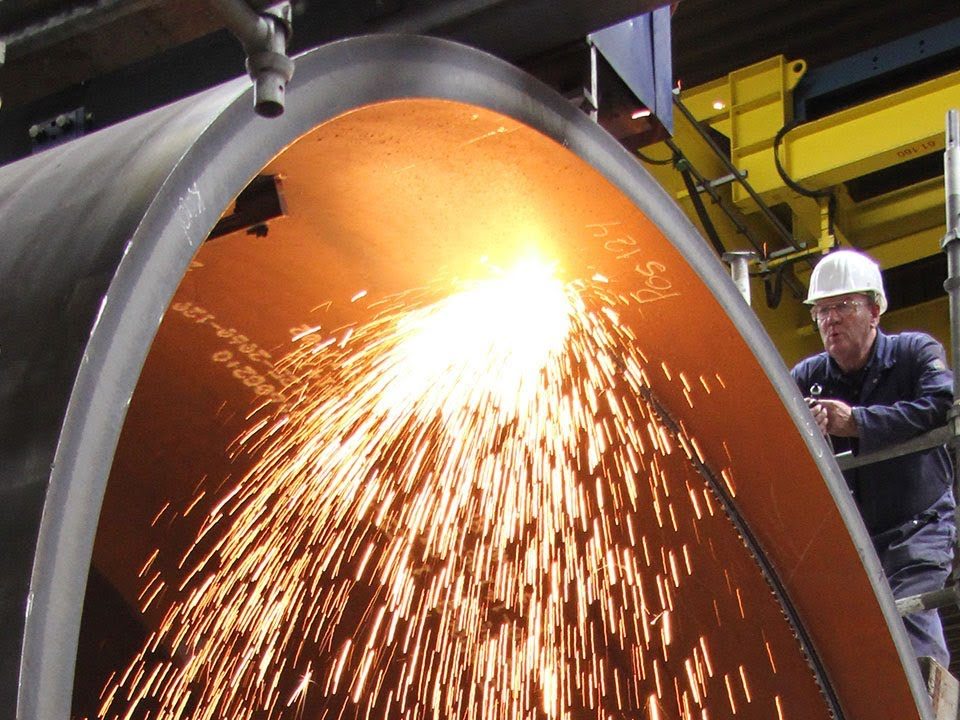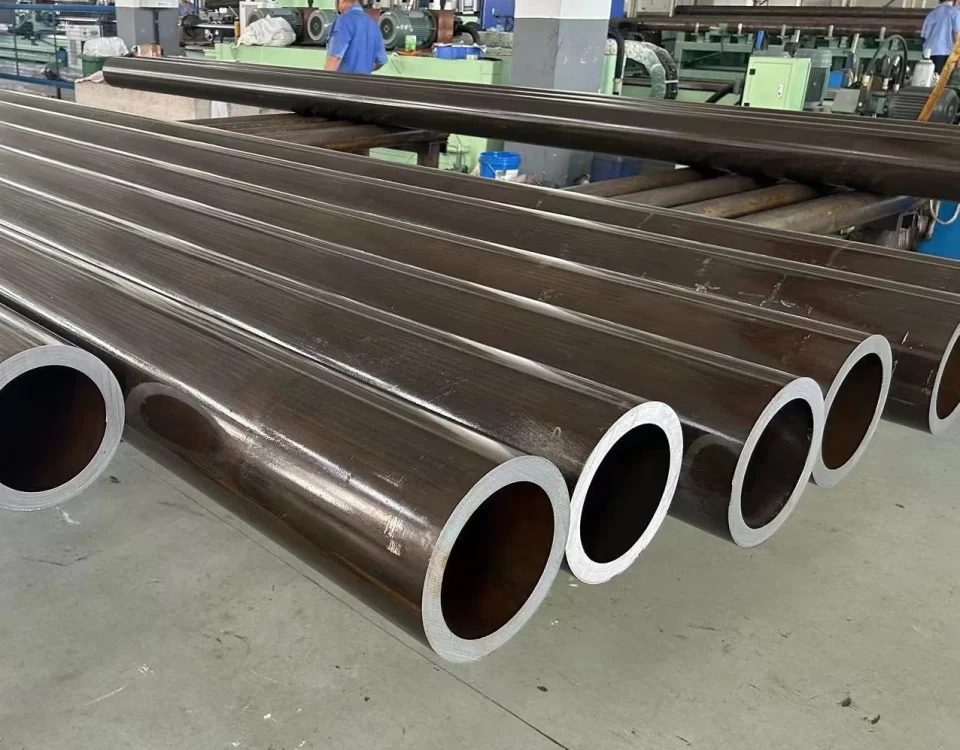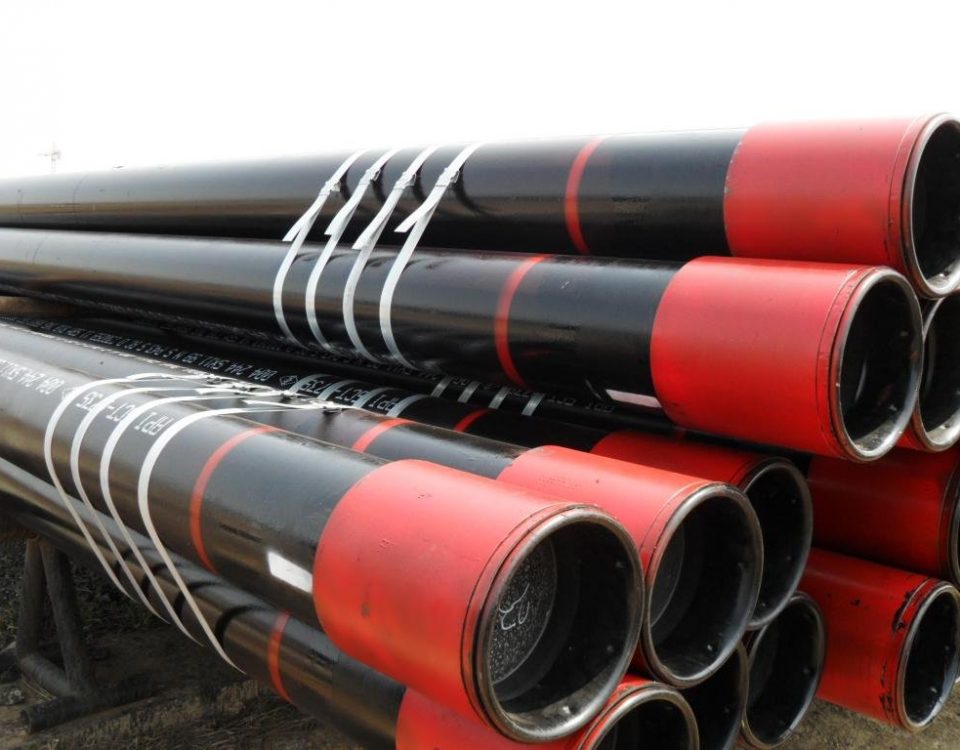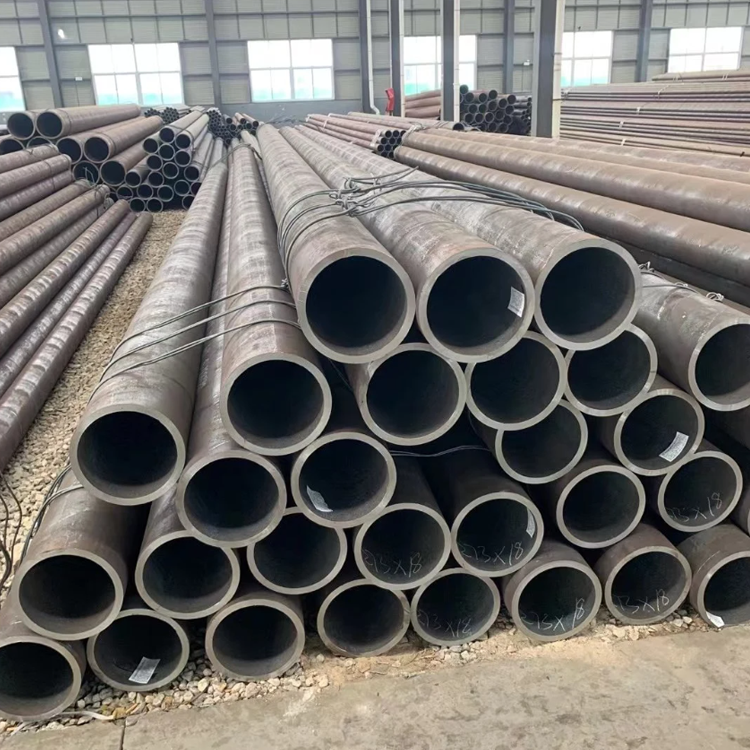
Tuyau structurel en acier sans soudure
août 22, 2023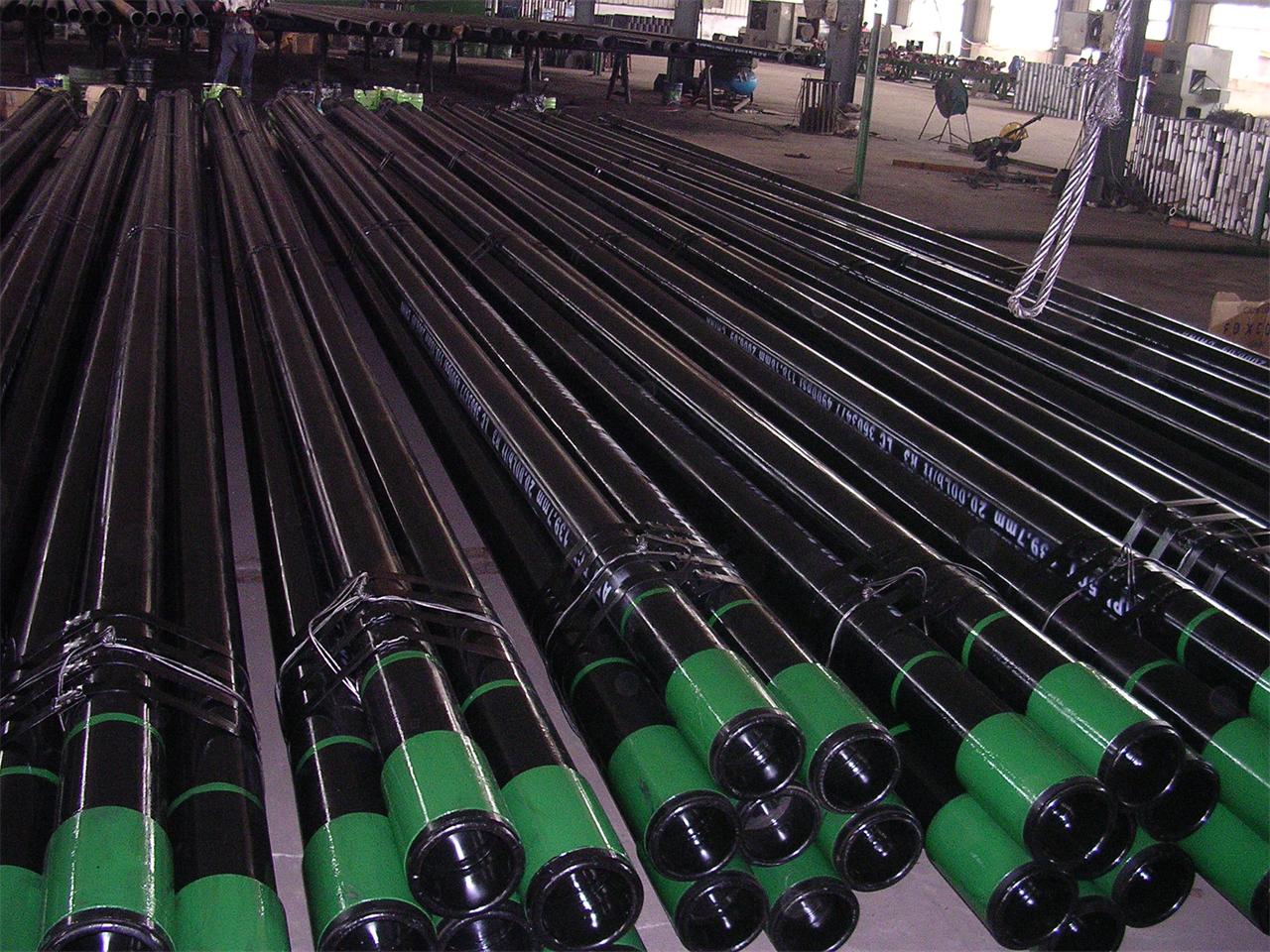
processus de traitement thermique des tuyaux de cuvelage d'huile,Comment les carters d'huile sont-ils inspectés et testés pour garantir leur qualité?
Septembre 4, 2023Boîtier d’huile à haute résistance et ténacité et son procédé de production
La description
Un tubage d’huile à haute résistance et ténacité est un élément essentiel dans les opérations de forage pétrolier et gazier. Il est conçu pour résister à une pression élevée, Matériaux abrasifs, et environnements corrosifs, Fréquemment rencontrés dans les opérations de forage. Le boîtier d’huile est souvent en acier et doit avoir des propriétés spécifiques comme une résistance élevée, tubulures de cuvelage pour applications amont, et corrosion la résistance.
Méthode de production
La méthode de production comporte plusieurs étapes, y compris la sélection des matériaux, le traitement à la chaleur, formant, et inspection.
1. Le choix des matériaux
Le matériau de base du boîtier est généralement un acier au carbone ou en acier allié de haute qualité.. Le matériau est sélectionné en fonction des conditions prévues de l’opération de forage, tels que la température, pression, et environnement corrosif.
2. Formant
L’acier est chauffé à une température spécifique, puis transformé en tuyaux. Cela se fait souvent par laminage à chaud, où l’acier est passé à travers une série de rouleaux qui le façonnent dans la forme et la taille de tuyau souhaitées. Les tuyaux sont ensuite refroidis et durcis.
3. Traitement thermique
Prochain, les tuyaux subissent un traitement thermique. Cela peut inclure la trempe et le revenu, qui sont utilisés pour augmenter la résistance et la ténacité de l’acier. La trempe consiste à chauffer l’acier à un haute température puis le refroidir rapidement, tandis que le revenu consiste à chauffer l’acier à une température plus basse, puis à le refroidir lentement.
4. Inspection et essais
finalement, les tuyaux sont inspectés et testés pour s’assurer qu’ils répondent aux normes requises. Cela peut inclure des inspections visuelles, Essais de dureté, et les essais par ultrasons. Si les tuyaux réussissent ces tests, Ils sont ensuite prêts à être utilisés comme carters d’huile.
Ceci est un aperçu de base de la façon dont les enveloppes d’huile à haute résistance et ténacité sont produites. Les processus réels peuvent être plus complexes et peuvent varier en fonction des exigences spécifiques du boîtier.
avantages
- Durabilité accrue: La haute résistance et la ténacité de ces boîtiers d’huile leur permettent de résister à une pression élevée et à des matériaux abrasifs, augmenter leur durée de vie et réduire le besoin de remplacements.
- Amélioration de la sécurité: Ces propriétés améliorent également la sécurité des opérations de forage, car ils réduisent le risque de défaillance du boîtier, qui peuvent conduire à des accidents catastrophiques.
- Rentable: Bien que le processus de production puisse être plus complexe et coûteux, La durabilité et la sécurité accrues de ces boîtiers peuvent entraîner des économies de coûts importantes à long terme..
Conclusion
La production de tubages d’huile à haute résistance et ténacité est un aspect essentiel pour assurer des opérations de forage sûres et efficaces. Bien que le processus de production puisse être complexe, Les avantages en termes de durabilité, sécurité, et les économies de coûts en font un investissement rentable.
L’invention appartient au domaine technique de la fabrication de tubes en acier sans soudure dans l’industrie métallurgique, et concerne en particulier un tubage de pétrole à très haute résistance et ténacité adapté aux puits profonds ou ultra-profonds et son procédé de production.
Technique de fond
Avec l’augmentation de la profondeur de forage dans les champs pétroliers et gaziers, l’augmentation de la température et de la pression, L’environnement géologique des tubages pétroliers utilisés pour les têtes de puits fixes a considérablement changé, et les conditions mécaniques utilisées ont également changé en conséquence. La charge d’extrusion externe qu’il supporte et les charges axiales sont de plus en plus élevées. Les boîtiers d’huile de haute qualité tels que V125 spécifiés par la norme de l’American Petroleum Institute utilisent généralement des aciers alliés de la série Cr-Mo-V. En raison de la fusion complexe, Procédés de laminage et de traitement thermique des carters d’huile de ce type d’acier, la composition de l’alliage et le procédé de fabrication ne sont pas appropriés. , entraînera une diminution de la résistance et de la ténacité du carter d’huile, et ne peut pas supporter la charge d’extrusion externe et la charge axiale apportées par les puits profonds ou ultra-profonds, ce qui aggravera les dommages et la défaillance du carter d’huile, et les dommages et la défaillance du tubage entraîneront facilement la défaillance du puits de forage. Problèmes complexes tels que l’instabilité, dommages au réservoir, Difficultés de forage et de cimentation, etc., menacer sérieusement la sécurité des opérations pétrolières, et même conduire à des pertes économiques majeures telles que des accidents de destruction de puits. Donc, Le champ pétrolifère impose des exigences plus élevées en matière de performance du tubage pétrolier.
Maintenant, Le problème à résoudre pour le tubage de puits profonds ou ultra-profonds est l’adéquation entre ultra-haute résistance et haute ténacité. La performance du carter d’huile à haute résistance et ténacité n’est pas seulement liée à la composition du matériau utilisé, mais aussi étroitement lié à son procédé de fabrication. Comme nous le savons tous, La ténacité aux chocs de l’acier à ultra-haute résistance dépend de la pureté de l’acier, la composition et le raffinement de la structure. La technologie de fusion ultra-pure est adoptée pour réduire la teneur en soufre, éléments impuretés phosphorés et gaz dans l’acier à ultra-haute résistance autant que possible, et réduire le nombre d’inclusions, afin d’obtenir une résistance aux chocs satisfaisante. Utilisation d’un procédé de traitement thermique approprié, La microstructure caractérisée par une martensite de latte ultra-fine comme phase ductile matricielle et austénite dispersée est obtenue en acier à ultra-haute résistance, et obtenus au cours du processus de laminage et de redressement La taille et la qualité de surface du carter d’huile de haute précision et la faible contrainte résiduelle sont les principaux moyens techniques et efficaces d’obtenir un boîtier d’huile à ultra-haute résistance et ténacité.
toutefois, Les nuances d’acier actuelles utilisées dans les enveloppes d’huile contiennent des impuretés élevées telles que le soufre et le phosphore, et la structure métallique contient des inclusions floconneuses. L’écoulement inégal du métal pendant le processus de laminage entraîne des propriétés mécaniques incohérentes dans les directions horizontale et verticale. En outre, dans la méthode actuelle de production de tubage d’huile, Le milieu de trempe dans le processus de traitement thermique est l’eau, ce qui est facile à provoquer des fissures. En même temps, en raison du processus de perçage et de roulage déraisonnable, PROCÉDÉ DE TRAITEMENT THERMIQUE ET PROCÉDÉ DE REDRESSEMENT, le meilleur La force et la ténacité du match de boîtier, et causer un stress résiduel excessif, et la précision des dimensions géométriques du boîtier est médiocre, ce qui affecte directement la capacité du produit à résister à l’effondrement.
Contenu de l’invention
Le but de l’invention est de pallier les déficiences de l’art antérieur et de fournir un tubage d’huile à haute résistance et ténacité pouvant répondre aux exigences des conditions de production parallèle en puits profond ou ultra-profond dans les champs pétrolifères..
Un autre but de la présente invention est de proposer un procédé de production d’un carter d’huile à haute résistance et ténacité, qui peuvent répondre aux conditions de production de puits profonds ou de puits ultra-profonds dans les champs pétrolifères.
La présente invention réalise par le biais du schéma technique suivant:
Un boîtier d’huile à haute résistance et ténacité, caractérisés en ce que les composants en pourcentage en poids sont: C: 0.22-0.35%, Si: 0.17-0.30%, Mn: 0.45-0.60%, Cr: 0.80-1.10%, mois: 0.70-1.10%, Al: 0.015-0.040%, Ni<0.20%, Cu<0.20%, V: 0.070-0.100%, N.-b.<0.050%, comme<0.0015%, P<0.010%, S<0.003% , et la balance est en fer.
Le rôle des principaux éléments d’alliage est:
C: 0.22-0.35%. C est un élément formant du carbure qui peut augmenter la résistance de l’acier. S’il est trop bas, L’effet n’est pas évident, et s’il est trop élevé, Il réduira considérablement la ténacité de l’acier.
Mn: 0.45-0.60%, Mn est un élément formant de l’austénite, qui peut améliorer la trempabilité de l’acier, augmenter la quantité d’austénite retenue dans l’acier, et affectent l'uniformité de la structure laminée à chaud.
Cr: 0.80-1.10%. Le chrome peut améliorer les propriétés mécaniques, résistance à la corrosion et trempabilité de l'acier, mais cela peut augmenter la fragilité de l'acier.
V: 0.070-0.100%, peut raffiner les grains, former des carbures, et améliorer la résistance et la ténacité de l'acier. Mais quand le contenu atteint un certain montant, l'augmentation de son effet ne sera pas évidente. En même temps, parce que le prix est élevé, le montant d'utilisation doit être limité.
mois: 0.70-1.10%, principalement grâce au renforcement du carbure et de la solution solide pour augmenter la résistance de l'acier, si le contenu est trop élevé, la ténacité de l'acier sera réduite.
N.-b.<0.050 affine principalement les grains et améliore considérablement la ténacité de l'acier à haute résistance.
Ni<0.20 améliore principalement la résistance et la ténacité de l'acier, améliore la résistance à la corrosion de l'acier, et réduit la température de transition fragile de l'acier.
Cu<0.20, le cuivre dans l'acier allié peut améliorer la résistance et la résistance à la corrosion atmosphérique de l'acier, trop d'ajout rendra l'acier cassant, généralement pas plus de 0.2%.
Afin d'assurer une excellente correspondance de résistance et de ténacité, le procédé de production du carter d'huile de la présente invention comprend les étapes suivantes:
(1) Fusion des ingrédients: Le fer spongieux et la ferraille d'acier sont utilisés comme matières premières pour la fabrication de l'acier., fondu en acier fondu dans un four à arc électrique (EFF), et l'acier fondu pour la fabrication des carters de pétrole est obtenu après raffinage à l'extérieur du four (SI) et le vide (VD) dégazage La composition en pourcentage pondéral est: C: 0.22-0.35%, Si: 0.17-0.30%, Mn: 0.45-0.60%, Cr: 0.80-1.10%, mois: 0.70-1.10%, Al: 0.015-0.040%, Ni< 0.20%, Cu<0.20%, V: 0.070-0.100%, N.-b.<0.050%, comme<0.0015%, P<0.010%, S<0.003%, et la balance est en fer.
(2) Coulée continue et laminage: L'acier fondu de haute pureté mentionné ci-dessus est coulé en continu pour former une billette ronde., et la billette de coulée continue refroidie est chauffée dans un four de chauffage annulaire. La température du four de chauffage des billettes de tubes est 1300-1320 ° C. , laminage continu, réduction de diamètre fixe, refroidissement, et scier; parmi eux, la température de centrage thermique est 1260-1270 ° C, la température de perçage chaude est 1240-1250 ° C, la température de laminage continu est 1070-1120 ° C, et la température de réduction de diamètre fixe est 910-910 °C 930°C.
Four annulaire:
Température de chauffage de l'ébauche de tube: 1280~1290℃, différence de température admissible: ±5℃.
Processus de perforation:
Un perceur conique à trois rouleaux est utilisé pour réduire la contrainte de cisaillement de perçage de l'acier allié et prévenir les défauts tels que les fissures., pliant, et délaminage à la surface du capillaire. Le taux d'allongement du piercing est 3.5-4.2, le rapport diamètre/paroi est 20-28, le taux d'expansion du diamètre est inférieur 35%, la vitesse de sortie de la machine de perçage est inférieure à 0,9 m/s, et la tolérance de diamètre de l'ébauche de tube rond de coulée continue doit être ≤ ± 1,4 % , Tolérance d'ovalité ≤ 2.5%, pour garantir la précision de la taille géométrique et de la forme du capillaire. La température de perçage est de 1240-1250°C.
Processus de laminage continu:
Le but du processus de laminage continu est de réduire le diamètre, étendre et réduire la paroi du tube capillaire transféré du processus de perçage, et en même temps améliorer la rugosité des surfaces intérieures et extérieures du tube vierge et améliorer l'uniformité de l'épaisseur de paroi.
Pendant le roulage continu, la surface interne du capillaire est en contact avec le mandrin en haut de la passe, mais pas sur le flanc. Le métal en haut du trou est étendu en raison de la pression externe du rouleau et de la pression du mandrin, et il se dilate dans la direction circonférentielle tout en s'étendant axialement, tandis que le métal sur la paroi latérale du trou se dilate également lorsque le métal en haut du trou s'étend. Il s'étire et rétrécit en conséquence dans le sens longitudinal. Contrôler le taux de réduction de chaque processus de laminage continu, de sorte que le rapport de la section transversale effective du tube ébauche avant et après déformation dans le processus de laminage continu soit 2.8 à 6.5, afin de garantir que l'énergie d'impact verticale et horizontale du carter d'huile tend à être cohérente. La vitesse d'entrée maximale du roulement continu est inférieure à 1,5 m/s, la vitesse de sortie est inférieure à 3,5 m/s, et le rapport entre la section transversale du tube capillaire et le tube vierge est d'environ 3.7. La température de laminage continu est de 1070 ~ 1120 ℃.
Processus de réduction de diamètre fixe:
Le processus de calibrage et de réduction est un processus de laminage continu de corps creux. En plus du rôle de dimensionnement, cela nécessite également un taux de réduction important, et le nombre de postes de travail est 24. Premier, les conduites d'évacuation sont chauffées entre 920°C et 1050°C dans le four de réchauffage puis évacuées. Après avoir mesuré la température de surface à la sortie de la table à rouleaux, un dispositif de détartrage à l'eau à haute pression de 20 MPa est utilisé pour retirer les tuyaux d'évacuation de l'unité de laminage continu pendant le processus de laminage. Échelle, puis laminé dans un broyeur de calibrage et de réduction. La température de laminage d'encollage est de 910-930°C, la vitesse d'entrée du roulement de dimensionnement est comprise entre 0,5 et 1,4 m/s, la vitesse de sortie est comprise entre 0,51 et 7 m/s, et le rapport de surface transversale effectif est compris entre 1.5.
(3) Traitement thermique: le processus de traitement thermique de trempe puis de revenu est adopté pour le tuyau vierge mentionné ci-dessus.
Le processus de trempe est le suivant: chauffer le carter pétrolier à 940°C. à 920°C. et le garder au chaud pendant 30 minutes pour former complètement l'austénite. Le milieu de trempe est un liquide de trempe huileux pour augmenter la résistance et la dureté de l'acier..
Le processus de trempe est le suivant: la température de revenu est de 640° C. à 660°C., conservation de la chaleur pour 2 heures, le refroidissement par air est utilisé pour affiner les grains de cristal, homogénéiser la structure, éliminer le stress interne, et améliorer la ténacité de l'acier.
(4) Le tuyau d'évacuation après le traitement thermique ci-dessus est soumis à un traitement de dimensionnement thermique et de redressage thermique., et enfin détection des défauts pour obtenir le tubage pétrolier fini.
Afin de minimiser les contraintes résiduelles du carter d'huile, réduire les contraintes résiduelles causées par le dimensionnement, améliorer la précision de la taille et de la rondeur du carter d'huile, et améliorer les propriétés mécaniques du carter d'huile, la température d'encollage est comprise entre 550 et 600 °C Pendant la période, la vitesse de sortie de dimensionnement du tuyau d'évacuation est comprise entre 1.2 et 2,4 m/s.
Dans le processus de lissage thermique, la réduction de la limite élastique de 1.55 à 1.75 fois (la réduction de la limite élastique est le point de départ de la déformation plastique de la surface du tuyau en acier) et la température de redressage appropriée sont sélectionnées pour réduire la contrainte résiduelle générée par le processus de redressage. Améliorer la rondeur et la rectitude du carter d'huile et améliorer les performances du carter d'huile. La température optimale déterminée par calcul théorique et expérience est de 450 à 580 °C., mais dans le processus réel, pour des raisons de sécurité, la température de lissage thermique est comprise entre 500°C et 540°C.
Afin d'améliorer les performances du carter d'huile, une plage de contrôle stricte de la précision géométrique a été établie. La précision géométrique du boîtier répond aux exigences suivantes: l'erreur de diamètre est de ± 0,8 % de la taille du diamètre, l'erreur d'épaisseur de paroi est de ± 8 % de la taille de l'épaisseur de paroi, et l'ellipse. L'erreur de rectitude de l'extrémité du tuyau est de ± 0,5 %, l'erreur de rectitude de l'extrémité du tuyau est de 1,5 mm/m, et l'erreur de rectitude du corps du tuyau est de 1,0 mm/m.
Le carter d'huile fabriqué par le procédé de production de l'invention peut atteindre la qualité d'acier V150.. Les indicateurs obtenus par les propriétés mécaniques du carter d'huile sont les suivants:
Limite d’élasticité: 1057~1210MPa
Résistance à la traction: ≥1180MPa
Résistance aux chocs: Énergie d'impact Charpy longitudinale à grande échelle ≥ 80J
Énergie d'impact Charpy transversale à grande échelle ≥ 75J
Élongation: ≥16%
La performance globale du boîtier (prenons φ244,48×15,11 comme exemple)
Résistance anti-effondrement du corps du tuyau: ≥80MPa;
Résistance au glissement: ≥2800KN;
Limite d'élasticité dans le tuyau: ≥115MPa;
Stress résiduel: ≤200MPa.
Dimensions géométriques du carter d'huile;
Plage de diamètre: 242.52mm ~ 246,43 mm;
Par rondeur: ≤1,2 mm;
épaisseur du mur: -8.0%t~8,0%t;
Rectitude: extrémité du tuyau 1,5 mm/m, corps de tuyau 1,0 mm/m.
La présente invention a l'effet technique suivant:
1. L'huile tuyaux de cuvelage la présente invention adopte un système d'alliage Cr-Ni-Mo-V, une nuance d'acier trempé et revenu, qui peut obtenir une certaine quantité de ténacité austénitique dispersée sur la matrice de martensite à lattes ultrafines après la phase de traitement thermique, améliorer la résistance et la ténacité de l'acier pour s'adapter à la charge d'extrusion externe et à la charge axiale apportée par les puits profonds ou ultra-profonds.
2. Dans le procédé de production de la présente invention, grâce à la formulation rationnelle de processus tels que le perçage et le laminage, les grains cristallins de l'acier peuvent être raffinés au maximum, et les défauts structurels peuvent être évités.
3. Dans le procédé de production de la présente invention, le choix du processus de traitement thermique est raisonnable, et il est possible de former une martensite à lattes d'ordre submicronique comme matrice, une particule de seconde phase à l'échelle nanométrique comme phase de renforcement des précipitations et une certaine quantité d'austénite avec une stabilité élevée. La structure composite multiphasée de la phase dure assure une excellente adéquation de résistance et de ténacité.
4. Dans le procédé de production de la présente invention, le processus de lissage thermique est raisonnablement formulé, ce qui peut minimiser la contrainte résiduelle du boîtier.
5. Une plage de contrôle stricte de la précision géométrique a été formulée, ce qui peut améliorer les performances du carter d'huile à un coût raisonnable.
6. Le milieu de trempe dans le processus de traitement thermique de la présente invention est un liquide de trempe huileux., ce qui peut éviter des défauts tels que des fissures sur la surface du tuyau en acier.
Moyens détaillés
La présente invention sera décrite en détail ci-dessous en conjonction avec des exemples spécifiques..
La présente invention sera décrite en détail ci-dessous en prenant comme exemple la production d'un carter d'huile φ244,48 × 15,11..
Exemple:
Le fer spongieux et la ferraille d'acier sont utilisés comme matières premières pour la fabrication de l'acier., et fondu en acier fondu dans un four à arc électrique. Après affinage hors four et dégazage sous vide, les composants de l'acier fondu pour la fabrication de cuvelages pétroliers sont: C: 0.22-0.35%, Si: 0.17-0.30%, Mn: 0.45-0.60%, Cr: 0.80-1.10%, mois: 0.70-1.10%, Al: 0.015-0.040%, Ni<0.20%, Cu<0.20%, V: 0.070-0.100%, N.-b.<0.050%, comme<0.0015%, P<0.010%, S<0.003%, et la balance est en fer.
L'acier fondu ci-dessus est coulé en continu pour former une billette ronde.. Chauffer la billette de coulée continue refroidie dans le four de chauffage annulaire, la température du four de chauffage des billettes de tuyaux est de 1310°C, après cela, centrage, Le tube en acier sans soudure au manganèse est un matériau relativement important pour les tubes en acier sans soudure, laminage continu, dimensionnement et réduction, refroidissement, sciage; parmi eux, le centrage thermique est de 1265°C , la température de perçage à chaud est de 1245°C, la température de laminage continu est de 1100°C, et la température de réduction du diamètre fixe est de 920°C. Il est rapidement refroidi à 450°C par lit de refroidissement et méthode de refroidissement par soufflage, et scier. Le processus de traitement thermique de trempe puis de revenu est adopté pour le tuyau vierge ci-dessus: trempe à 930°C (liquide de trempe huileux), revenu à 645°C. Après calibrage à chaud à 560°C, lissage à chaud à 520°C, et détection finale des défauts, le carter d'huile fini est obtenu.
Dans le processus de perçage, le taux d'allongement est 3.7, le taux d'expansion du diamètre est 28%, et la vitesse de sortie de la machine à percer est de 0,7 m/s. Dans le processus de laminage continu, le rapport de la section transversale effective du tube stérile avant et après déformation par roulement continu est 4.3, la vitesse d'entrée est de 1,2 m/s, et la vitesse de sortie est de 2,9 m/s. Dans le processus de diamètre fixe et réduit, le rapport de surface transversale effectif est 1.2, la vitesse d'entrée est de 0,9 m/s, et la vitesse de sortie est de 1,3 m/s. La vitesse de sortie de dimensionnement du tuyau vierge est de 1,8 m/s. Dans le processus de lissage thermique, le coefficient de réduction de redressement est 1.6 fois la réduction de la limite élastique.
Les propriétés mécaniques du carter d'huile produit par la méthode ci-dessus peuvent atteindre les indicateurs suivants:
Limite d’élasticité: 1109MPa;
Résistance à la traction: 1213MPa;
Résistance aux chocs: Énergie d'impact Charpy longitudinale à grande échelle: 121J;
Énergie d'impact Charpy horizontale à grande échelle: 114J;
Élongation: 17%.
La performance globale du boîtier:
Résistance à l'effondrement des tuyaux: 93.1MPa;
Résistance au glissement: 3208KN;
Limite d'élasticité dans le tube: 130.6MPa;
Stress résiduel: 162.31MPa.
Dimensions géométriques du carter d'huile:
Plage de diamètre: 245.90mm~246,20 mm;
Par rondeur: ≤0,6 mm;
épaisseur du mur: -4.5%t~7,0%t;
Rectitude: extrémité du tuyau 1,2 mm/m, corps de tuyau 0,9‰.
Le carter d'huile produit grâce à la conception en acier de l'invention et au contrôle raisonnable de diverses conditions de traitement peut répondre aux exigences de résistance et de ténacité des puits profonds ou des puits ultra-profonds.. Contrôler la déformation par roulement et le traitement thermique, obtenir des effets tels que le renforcement des précipitations, raffinement du grain et renforcement de la transformation de phase, améliorer la résistance et la ténacité de l'acier, et résoudre le problème des fissures faciles dans le traitement thermique des tuyaux en acier sans soudure en acier allié. Utilisation des méthodes de traitement d'encollage thermique et de redressage thermique, la faible contrainte résiduelle requise par les tubes en acier sans soudure est résolue, et la flexion, déformation elliptique, et la précision dimensionnelle des tubes en acier sans soudure sont contrôlées.

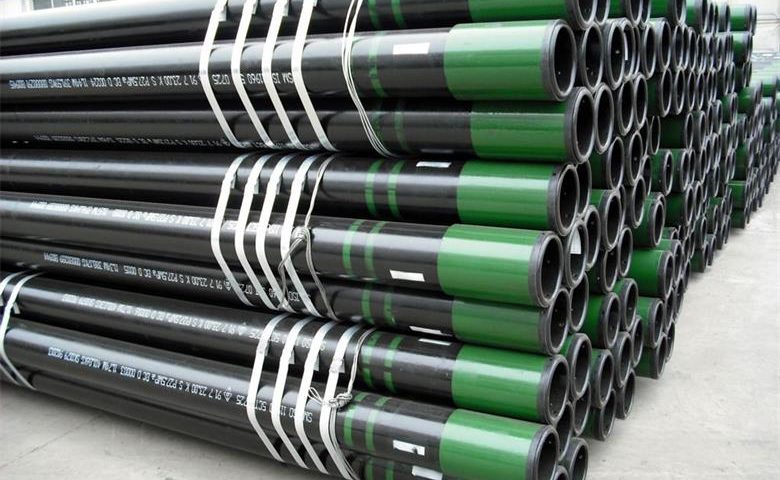
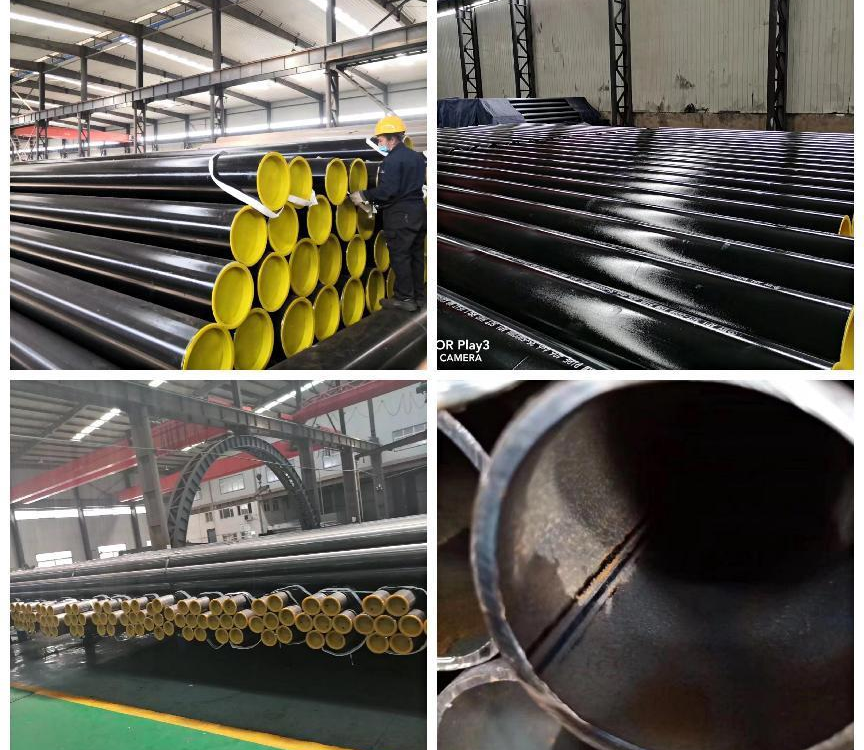
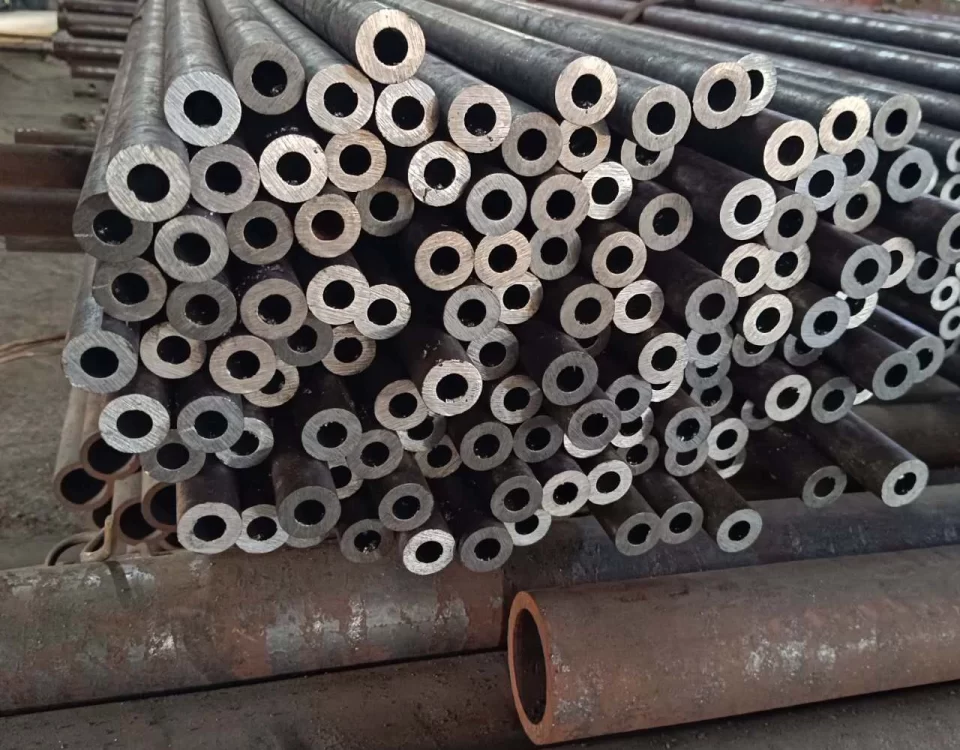
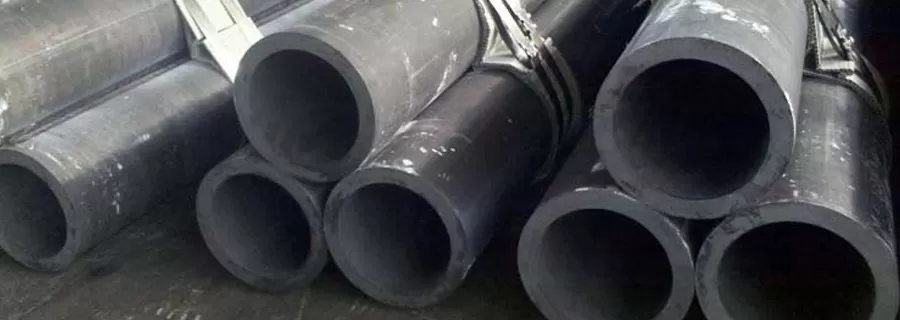
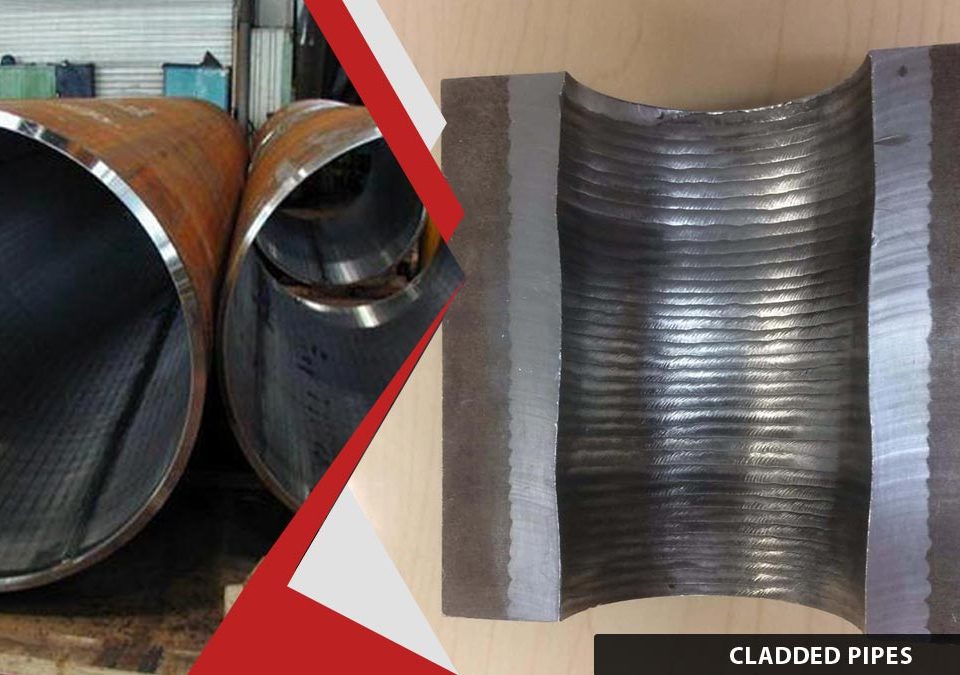
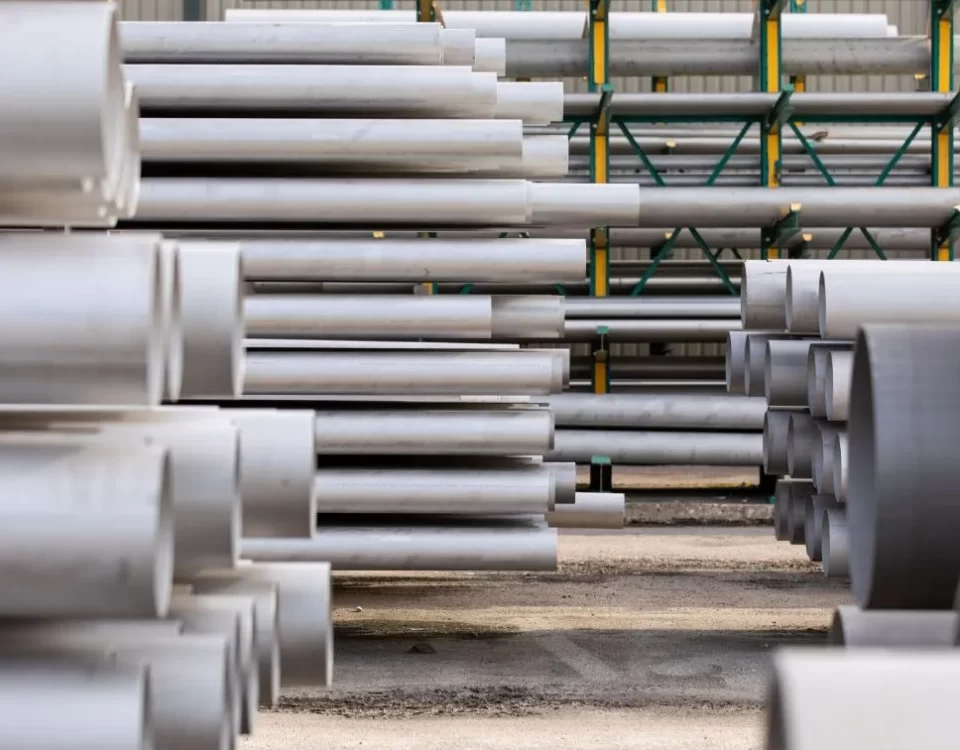
-steel-pipe.jpg)
